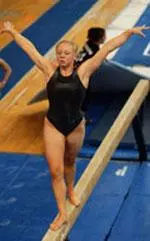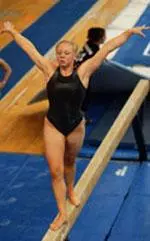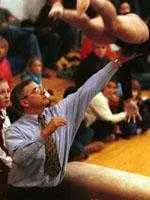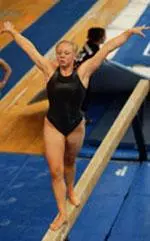University of Massachusets Athletics
UMass Announces Cuts To Athletic Budget
March 11, 2002 | Women's Gymnastics
March 11, 2002
AMHERST, Mass. - In an effort to respond to fiscal realities and to strengthen the campus's athletic base, the University of Massachusetts is reducing its number of intercollegiate sports from 29 to 22 at the end of the current academic year. The seven sports to be eliminated are: women's volleyball, men's and women's water polo, men's and women's gymnastics, men's tennis, and men's indoor track and field. The cuts will allow the University to reallocate some scholarship funds, and will allow UMass to re-main in compliance with Title IX and exceed the law's proportionality requirements.
Chancellor Marcellette G. Williams and Athletic Director Robert K. Marcum made the announcement. They said by funding 22 intercollegiate sports, UMass will still exceed the national average of other major public institutions. The national average for Division I public institutions is 18 sports.
Currently 136 students participate in the seven sports out of about 800 varsity athletes at the University. Marcum said the budget for the seven sports is approximately $1.1 million per year. Positions eliminated will include four full-time head coaches, two full-time assistant coaches, and four part-time assistant coaches.
Williams said: "We regret the necessity of making this announcement. This decision in no way reflects on the dedication, passion, and abilities of the many people who have contributed to these sports over the years. The sports involved, the coaches involved, the alumni, and the student-athletes who will be affected have contributed greatly to the life of the University."
However, Williams said, "Given the financial situation in the Commonwealth and a budget cut of nearly $17 million to the campus in the current fiscal year, we had to make this regrettable move." The Athletic Department cuts follow an announcement in January of 95 layoffs in campus support units, and were carried out in the context of an ongoing review of all administrative and academic programs on the campus. A statewide early retirement package may also leave as many as 350 positions vacant across the campus, Williams said.
Marcum said: "Our charge has been to build a top rate Division I athletic program for the Commonwealth. The resources made available by the University, the Board of Trustees and the state, have enabled us to fulfill that charge, both academically and athletically. Due to the current budgetary crisis that the state and the University are facing, we received a mandate from the University to reduce the program. We have done that with the goal that the remaining programs will be stronger and more competitive. We fully understand what is taking place financially throughout the institution, and that the reduction in athletics is just one of many reductions being considered."
Marcum pointed out that among all public institutions in the nation, only Ohio State, with 35, has more sports than UMass. Penn State, UMass, and Rutgers are tied for second with 29. North Carolina is next with 28, and California, Vermont, and James Madison follow with 27, although Vermont has announced it will eliminate five of its 27 sports at the end of the current academic year. Michigan State and Maryland, with 26 sports each, round out the top 10 list of public schools sponsoring the most sports. All but two of the top10 devote considerably more resources to athletics than UMass does, according to Marcum. Public institutions that sponsor 22 sports include the University of Kentucky, North Carolina State, and Temple. Institutions with fewer than 22 sports include the University of Florida, Kansas, Georgia, Texas, and Purdue.
Marcum said that sports were selected for elimination based on a variety of factors. These included the national and regional health of the sport, Title IX participation considerations, facilities issues, the overall strength and success of the sport at UMass, in-state vs. out-of-state participation, and the financial resources that would be required to bring the sports to a more competitive level in the future. In evaluating the programs, certain criteria were in direct conflict with other criteria. In some cases, win/loss records and post-season success were outweighed by other factors, Marcum said.
"This action impacts a lot of people," Marcum said, "and we sympathize with those athletes and coaches who have given so much of themselves to the University and the Athletic Department." He added that to assist with the transition, existing athletic aid that student-athletes in the affected sports are receiving will be extended for one additional year (the 2002-03 academic year). For those choosing to transfer and to continue their athletic careers at another school, he said, "We will do everything in our power to assist them through that process."
President William M. Bulger said: "We believe this action will allow the Amherst campus to maintain the athletic excellence that has become its hallmark. I am confident that in concentrating and focusing our efforts in this manner, the result will be greater stability and greater success. I would also like to emphasize to the current student-athletes and coaches, as well as those who are considering coming to the University in the future, that we are committed to strengthening the remaining programs and ensuring they are able to be competitive in the future."
Grace K. Fey, chair of the University of Massachusetts Board of Trustees said: "I take great pride in what our athletes have been able to achieve both on the playing fields and in the classroom. The athletic program in Amherst has been a true center of excellence for many years, and I have no doubt that it will continue to be a beacon of accomplishment in the years to come. In that light, we recognize that to be competitive, the program must have our support. We are committed to having a strong athletic program that the University and the Commonwealth can be proud of."




